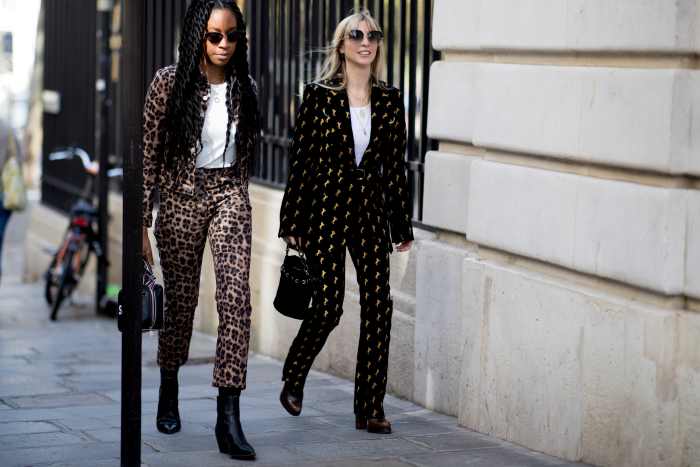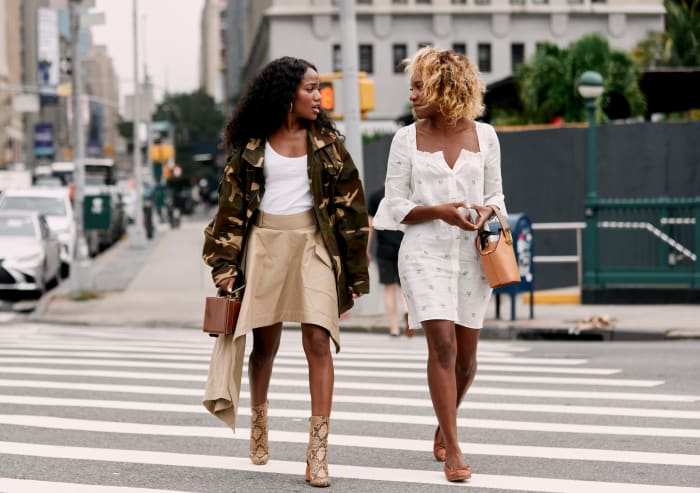Is the Fashion Industry a Good Career
The role of the style editor — the career that'due south been glamorized on Goggle box, in movies, through literature and, of course, in magazines — is on shaky ground. As the media landscape continues to struggle and shrink, with frequent layoffs and upkeep cuts condign the new normal, many editors report being both underpaid and uncertain virtually their futures.
The integration of print and online staffs at publishing houses similar Hearst and Condé Nast is partially to blame: Faddy, the industry's crown jewel and ordinarily one of the final titles standing when it comes to momentous change, has cut 24 positions from its masthead since June 2018, for example. Many of those roles, including the magazine's caput creative director and various visuals editors, are unlikely to be refilled, suggesting that the positions themselves may get extinct. For those editors still on staff at style glossies, an endless stream of industry events — and the push from the digital side to reach e'er-growing traffic goals — has led to a quiet, commonage exhaustion.
Editors, particularly of the fashion and lifestyle variety, have been prominent figures in popular culture for decades: Retrieve Andy Sachs in "The Devil Wears Prada," Lauren Conrad's stint as a Teen Faddy intern on "The Hills" (aslope "super-intern" Emily Weiss, who eventually founded Into the Gloss and Glossier), Jenna Rink in "13 Going on 30," Betty Suarez on "Ugly Betty" and, of form, Carrie Bradshaw on "Sex and the City." On account of this, young people who aspire to a life in the big city and a job that counts world travel, free designer clothing and admission to exclusive events as perks tin go sucked into the fantasy, thinking that working their fashion up the masthead in the once-booming magazine business concern is still a viable career option. Unfortunately, the reality is much more than murky, and ane that editors working today are struggling to grapple with.
As for what a fashion editor can do when their job is on the chopping block, ane pick is the much-discussed (and debated) editor-influencer office, which sees staffers with significant accomplish on social media (Instagram in particular) partnering with brands on paid content creation and product placement that is often more lucrative than their day jobs. While curating products and introducing consumers to what's new and adjacent has long been the duty of market editors, it's now being played out every bit much on their personal feeds — if not more — than in magazines themselves.

'Harper'southward Bazaar' editors Chrissy Rutherford and Kerry Pieri at Paris Mode Week. Photo: Imaxtree
Other editors, perhaps wary of their job security, have jumped ship to work at brands that are looking to develop their own content platforms in the vein of a Glossier or Goop. In the concluding year, for instance, companies ranging from Rent the Runway to SoulCycle have made hires from traditional media in an effort to build out their own editorial departments. It's non simply junior staffers that are leaving, either: Senior talents like Maria Dueñas Jacobs, the former accessories manager of Elle, and Linda Wells, the founding editor of Attraction, have moved to Stitch Fix and Revlon, respectively.
These shifts beg the question: Has the traditional role of "fashion editor" — one whose coverage is not swayed by gifts or budgetary compensation, whose online following is irrelevant and who works behind the scenes for a media company rather than a make — go a matter of the past?
The industry is decidedly split on how to answer that question. "If I'chiliad looking at someone for a job, I don't wait at their social post-obit," says Laura Brown, the editor-in-main of InStyle who has become an influencer in her ain right, thanks to her candid, tongue-in-cheek musings on Instagram. "How many apparent humans follow you on social media is less of import to me than how you lot do your chore and what you have to say."
Case in point? When she hired Laurel Pantin to be InStyle's fashion features director last year, she had no idea the editor came with 37,500 Instagram followers on her personal business relationship and brand partnerships to kick — something she claims to have discovered afterwards the fact. "I just thought she was great," Brown explains.
Editors at publications like The Cut and The Zoe Report agreed with Brown that social prowess is less important for on-staff style editors than it's often made out to be. "I don't think it's very of import at all," says Lauren Caruso, The Zoe Report's managing editor, who has previously contributed to Fashionista. "I'1000 more than concerned with somebody'south feel and skill level for the job at manus, which usually surrounds writing, editing, managing a team and cultivating brand relationships."
Nonetheless, Caruso is an influencer herself — one who has worked with large, corporate brands similar Wells Fargo and Vicks on paid posts that wait surprisingly chic and right at dwelling in her minimalist feed. Juggling both roles has been a perk, she says; information technology keeps her abreast of new brands, many of whom reach out to her outset, as well equally new product launches, which influencers are oft tapped to promote before anyone else.
Those who don't boast a sizable social media following like Caruso admit that they do feel the pressure level to develop a so-called "personal brand" — and fear that the days of choosing to remain behind-the-scenes are swiftly coming to an terminate.
Recommended Articles

Bustle Senior Fashion Market Editor Gabby Prescod (left) and BET Manner Director Danielle Prescod (right) at New York Fashion Calendar week. Photograph: Imaxtree
"Publishers and brands identify value on the telescopic of your reach and your overall visibility, so past not engaging with social media in that capacity, you lot could be missing out on opportunities that advance your work," says Nicole Kliest, a freelance author and editor who was formerly the mode manager at Who What Clothing.
A smaller following oft means fewer perks, too: Ad sales departments at legacy publishers have been known to give budgetary bonuses to buzzy editors who promote certain advertisers on their personal social feeds, offer them upwards as added value. Additionally, brands are more than inclined to accomplish out to this accomplice for press trips and event invites — oft planned specifically around sharable Instagram moments — a reality that tin pb to lucrative networking and exclusive content for the chosen few editors.
For Michelle Lee, the editor-in-principal of Allure, editors with a social following are definitely "nice to have," equally their success can accept a ripple result on the larger publication, providing it with fresh ways to connect with and abound its audience. "You can parlay their talent for your brand," she says, pointing to her old employee Kristie Dash (who now handles beauty partnerships at Instagram under the leadership Eva Chen, another quondam Condé Nast editor-in-principal) every bit an example. "Her personal Instagram and Snapchat accounts were so expert that I asked her for help with Allure'south as well." But, she notes, it'south important for these editor-slash-influencers to avoid conflicts of involvement by running any potential paid partnerships by her first.
Brown, for her office, takes a hands-off approach, though she has witnessed editors become as well focused on their influencer projects, causing them to have their eyes off the ball at work. "You tin't forget that you represent the publication you work for just as much as you correspond yourself," she says.
Walking that line is non always easy, and the stress of juggling both roles has led some of these influential editors to strike out on their own. "Many people don't realize the fourth dimension and effort it takes to run an influencer business organisation, and doing that alongside a demanding full-time senior editor chore in digital media was far from easy," explains Alyssa Coscarelli, who left her job as Refinery29'southward senior market place editor late last twelvemonth. "Add together to that the conflicting scheduling and larger conversations with my employer well-nigh how to handle information technology all and, truthfully, information technology can get a bit complicated."
Coscarelli is hesitant to call the influencer road a better bet for today'southward aspiring manner editors, proverb it should exist evaluated on a case-by-case footing, but admits that she did feel justified in her move given the electric current state of the manufacture.
The money isn't bad either: One influencer marketer who has worked with editor-influencers including Coscarelli notes that they can brand anywhere from $5,000-$vii,500 for a unmarried sponsored postal service, which is significantly more than the salaries almost traditional editors are paid per month. Larger projects that involve numerous deliverables across platforms can attain upwards to $500,000, depending on follower count and engagement.

Alyssa Coscarelli (left) and Lauren Caruso (right) at New York Mode Week. Photograph: Imaxtree
Working for brands tin can also exist cushier gigs, and equally media jobs dry upwards, branded editorial work seems to grow in their identify as more companies invest in storytelling around their products. "There's never going to exist as many jobs in publishing and media as there are talented people, so editors hopping to brands is merely a circumstance of that," argues Diana Tsui, senior fashion marketplace editor at The Cut.
Kliest, who worked every bit the editorial lead for Orchard Mile later leaving Who What Article of clothing, has tried her paw at both worlds and found that there was significant overlap with the work involved. "Equally more editors go freelance [as a result of] layoffs and an overall ambiguity regarding the publishing world, it behooves them to pitch their journalistic skills to these brands because, as I've learned, they translate," she says.
Indeed, the editorial world is unlikely to return to its Golden Age of bloated mastheads, black cars and aplenty task opportunities. One publishing expert at the Poynter Institute for Media Studies predicts that, in the fashion magazine world, especially, layoffs and upkeep cuts will continue apace as audiences go along to shift towards digital-outset content. Nonetheless, that doesn't hateful it's fourth dimension to buss your manufacture aspirations goodbye: The highest-ranking way and market editors are probable to remain in place even as their junior counterparts lessen in number — way is stubborn, after all. Just for those editors who don't qualify — or for immature people who still dream of a lifestyle they've watched play out on the big or small screen — it certainly doesn't hurt to get creative and telescopic out other options.
Stay electric current on the latest trends, news and people shaping the way industry. Sign up for our daily newsletter.
0 Response to "Is the Fashion Industry a Good Career"
Post a Comment